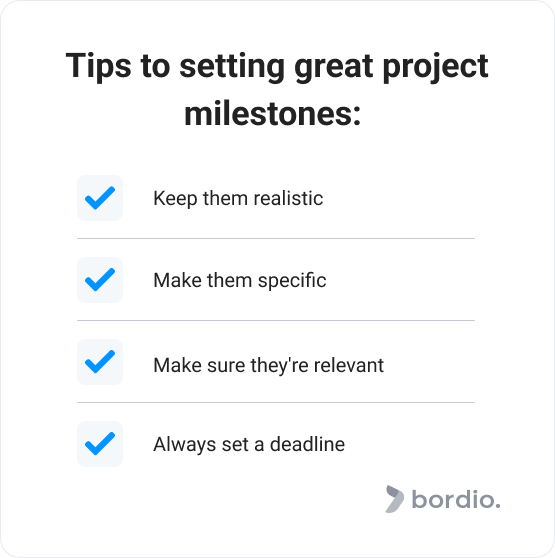In project management, a milestone is a point of progress on the project timeline.
You can also think of them as moments in time. Milestones usually signify important steps in the development in your task tracking app, that must be achieved for the project to turn out a success (i.e., to deliver satisfactory deliverables on time and within budget).
In other words, milestones are key moments in the project life cycle, that is fixed in the project schedule maker that support the team’s journey towards the project’s due date.
Milestones are used as project timeline dividers and reasons for little celebrations. They also help the team feel less overwhelmed. When there are smaller milestones on the way, instead of just one fat objective at the end, team members tend to endure less stress because they get many smaller goals instead of a single big scary task. So for the good of a team you can use milestones placed in the schedule planner.
Milestones are usually (but not always) defined during the early days of project planning.
Milestones are NOT goals
When you hear about milestones, the first instinct is to call them goals because they seem to be the same. It is wrong, however, to equate the two.
A milestone is one of the many events on the way to your goal. For example, if you are building a house, the end goal would be to have a fully finished house where a family can live with all conveniences. The milestones here could be connecting all the utilities, finishing with the basement, or moving on to interior works. This means that the goal is the end product and the milestones are the components of the plan in the best time planner to achieve them.
What else is the milestone not?
Milestones are not project deliverables. A deliverable is a product or service but a milestone is a point in time. For example, hand cream is a deliverable in the cosmetics company’s new project. Confirming and approving the hand cream formula before sending it to production is a milestone.
Milestones are not project phases either. A project phase takes time to complete, whereas a milestone is simply an event that is acknowledged before moving on. Sometimes project phases and milestones merge into one but it’s not a rule.
Project milestone examples
The beauty of milestones is that they can be added anywhere and everywhere. There is no industry or project where there wouldn’t be a place for them.
Let’s look at a few project milestone examples in different industries and teams.
Project milestones example #1: website development
Say you are a small business and you need a website to support your sales and drive traffic. Here are a few potential milestones that your website development team might have:
- Website structure approval by March 1
- All texts are written by March 20
- Design Approval by March 29
- Programming Finished by April 19
- QA Testing is done by April 29
Project milestones example #2: marketing campaign
Once your website is finished and launched, it is time to think about finding more leads and, hopefully, generating more profit. You can also use a digital marketing agency for startup to create an advertising campaign. So the next project to tackle is a marketing campaign with the following possible milestones in your best electronic planner:
- Concept & Offer approved by May 11
- The photoshoot is done by May 15
- Banners ready by May 20
- Video ready by May 22
- Homepage banner ready by May 24
- Google Ads setup by May 27
- Facebook Ads setup by May 30
- Campaign launch by June 3
Different types of milestones in software development project management
Working with a development company offers a valuable opportunity to gain insights from industry experts in software development project management. Here are a few more software development milestones examples:
- Receiving feedback from key stakeholders. Negative or positive, hearing feedback on your solution from key stakeholders is a big deal, so it is often used as one of the project milestones.
- Having the final approval of the project plan. That’s a typical project milestone that the teams from Lean to Waterfall use. This milestone symbolizes that the project phase of active work can finally start for the team.
- Completing a crucial feature within the software. If we are talking about Scrum or Agile projects, then such a milestone will likely coincide with the end of one of the sprints. However, not all features and critical tasks should be set as milestones, placed in time management tool, but rather flagship functionality or the technology that will be used for many more other tools, therefore, a critical one.
- The testing phase is over. Let’s say you are launching a brand new SaaS. It’s important to make sure it works well, can handle heavy workloads, and is secure for the clients to use. All those things must be tested, possibly several times. So naturally, finalizing the testing phase will be a pretty big deal that deserves to be turned into a milestone.
- Reaching KPIs. Key performance indicators, or KPIs, measure the project’s overall progress and individual goals. Reaching KPIs demonstrates that you are doing everything right. Whether you partner with nearshore software development companies or manage development in-house, regular KPI tracking can help ensure projects stay on track, meet quality standards, and deliver value.
- Getting the next round of funding from investors for a startup that’s just presented its MVP. Such an important project milestone example symbolizes not only an important milestone but a chance to bring their vision to life.
Why are milestones in project management important?
Project management milestones have several functions that support the project team and, frankly, the project progress as a whole.
- Signifies progress. Projects can be tiring. It’s a lot of work under time pressure. Milestones help take a break from the daily avalanche of tasks in the online to-do lists, look back at what’s already been done, and pat yourself on the back.
- Motivates the team. Don’t ever underestimate the importance of little wins and celebrations. Reaching a project management milestone means achieving something, and that can and should be used as a motivational boost for the project team. Step-by-step planning is important for motivation and if you are working with a team remotely it will be most convenient to use software to manage remote employees.These days it’s common, for example, to work with developers from South America, marketers from Eastern Europe, etc., so for business it’s important to be on the same page with their remote teams.
- Helps monitor progress and deadlines. The project schedule is usually tight and must be watched carefully to ensure timely project completion. Project milestones are an extra layer of monitoring that helps the project manager stay on track.
- Holds the project team accountable. Just like milestones can be used to track the project progress, they can spot the lack thereof. Knowing that there’s a milestone coming up that must be achieved, the team will be more inclined to do the work instead of procrastinating and wasting time.
- Strengthens the project plan. We outline all big events and critical tasks on the project timeline and can plan better in team’s virtual planners, including planning when the project will be finished.
- It’s easier to spot potential risks and bottlenecks when we have more factors to evaluate the progress on.
How to identify project management milestones?
Let’s start by saying that milestones in project management don’t always have to be very serious.
It’s okay for you to have some fun with them on a project. For example, if one of the project suppliers keeps on missing the delivery deadline, you can set up a milestone for when they deliver on time and have a little celebratory cake and coffee with the team. Similarly, if your weekly planners are always packed and you finally get a somewhat relaxed week because you’ve completed a lot of tasks in advance, – this can also be a milestone.
Tips for building the best project milestones
We mentioned earlier that project milestones and goals are not the same.
But when it comes to identifying milestones, we can learn from the goal-setting experience and implement those recommendations for milestones too:
- Make project milestones realistic. They should be challenging but achievable, otherwise, they will only demotivate the team and cause despair.
- Project milestones should be specific. There are not many things that people in project management hate quite like ambiguity. Don’t leave your team wondering what the project milestone means and what the achievement criteria are.
- Keep it relevant. It’s fine if you want to be creative or think outside of the box. But remember that the project milestone must relate to the project scope. If it doesn’t – it’s out.
- Project milestones should be time-bound. They need to be tracked against a project schedule and have a due date. There might be exceptions to this, but the general rule is that milestones must help your team stay on track, and it can only be achieved if all project-related events have deadlines. Add them to your online calendar planner to make sure you don’t miss them and that they encourage you to work harder.
Also, make sure you place milestones on the timeline correctly. A milestone is a moment in time associated with an event or occurrence. So the deadline for the milestone should reflect that. Say you have a movie premiere. The milestone should be set for the day when the premiere happens and not the night before when the final preparation work is finished.
There is no rule or formula for how many milestones each project should have. It’s just as fine to have two as to have ten, as long as they are not forced by an overly excited project manager. As long as milestones make sense and the team supports them, you are good to go.
Another point that’s important to accept is that not every single milestone will be achieved on time or at all.
While it is a bummer for sure, it’s not necessarily a deal-breaker. If that happens in your project, take a deep breath and have a closer look at the situation:
- What caused the milestone to not be achieved?
- Was there a mistake in the original project plan?
- Does it affect key project deliverables?
- How critical is this for the project’s completion?
To reduce the chance of having failed milestones, ask everyone to implement daily planning software that will not only boost accountability but also automate the process. The more instruments you have at your disposal, the less likely you are to set incorrect milestones.
Final thoughts on project milestones
Project milestones serve as an extra shield for the project against failure. It makes everyone’s work better. Teams get an extra motivation boost and a target to aim other than project goals. Project managers can use milestones to track the project’s progress and showcase it to the stakeholders.
We hope that our project milestones examples have given you a good idea and an inspiration to utilize milestones in your project management process more.
If you’re interested in other project management tools, we recommend looking into the project communications plan, critical path method, and Kanban boards. Each of those tools serves a different purpose, and together they will help you reach the desired project outcomes. Don’t forget to chech out our handy online weekly schedule maker.









